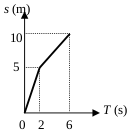Average velocity – problems and solutions
1. Someone rounds a rectangle with a length of 400 m and width of 100 m, 12 times in 1 hour. What are the average velocity and the average speed?
Known :
Length of rectangle = 400 meters
Width of rectangle = 100 meters
Circumference of the rectangle = (2 x 400 meters) + (2 x 100 meters) = 800 meters + 200 meters = 1000 meters
Distance = 12 x 1000 meters = 12,000 meters = 12 kilometers
Wanted : The average velocity and the average speed
Solution :
The average velocity :
The person return to the initial velocity after rounds rectangle, hence displacement of the person is 0 and the average velocity is 0.
The average speed :
The average speed = total distance / time interval = 12 km / 1 hour = 12 km/hour
2. The connection between the distance (d) and time interval (t) of a moving object shown in the figure below. If the distance in meter and time in second, what is the average velocity.
Solution
The average speed = distance / time interval
The average velocity = 15 meters / 6 seconds = 2.5 meters/second
3. A bird flies towards the North at 16 m/s in 5 second and then towards the East at 12 m/s in 5 seconds. What is the average velocity for 10 seconds.
Solution :
The velocity of bird towards the north : 16 meters/second = 16 meters / 1 second
After 1 second, bird moves as far as 16 meters
After 2 seconds, bird moves as far as 2 x 16 = 32 meters
After 5 seconds, bird moves as far as 5 x 16 = 80 meters
The velocity of bird towards the east : 12 meters/second = 12 meters / 1 second
After 1 second, bird moves as far as 12 meter
After 2 seconds, bird moves as far as 2 x 12 = 24 meters
After 5 seconds, bird moves as far as 5 x 12 = 60 meters
Displacement (s) :
s = √802 + 602
s = √6400 + 3600
s = √10,000
s = 100 meters
The average velocity (v) :
v = displacement / time
v = 100 meters / 10 seconds
v = 10 meters/second
1. Question: What is average velocity? Answer: Average velocity is the total displacement of an object divided by the total time taken. It’s a vector quantity and has both magnitude and direction.
2. Question: How does average velocity differ from average speed? Answer: Average speed is the total distance traveled divided by the total time taken, and it doesn’t consider direction. Average velocity, on the other hand, considers the overall displacement (change in position) and its direction.
3. Question: If a car travels 200 km north and then 200 km south in a total of 8 hours, what is its average velocity? Answer: The car returns to its starting point, so the total displacement is 0 km. Therefore, its average velocity is .
4. Question: Can average velocity be negative? Answer: Yes, average velocity can be negative, depending on the chosen reference direction. If an object moves in the opposite direction of the reference, its average velocity will be negative.
5. Question: Why is average velocity a vector quantity? Answer: Average velocity is a vector quantity because it has both magnitude (how fast the object moves) and direction (which way the object moves).
6. Question: If the displacement-time graph of an object is a straight line, what can you say about its average velocity? Answer: If the displacement-time graph is a straight line, the object has a constant velocity, and its average velocity over any time interval will be the same as its instantaneous velocity at any given point.
7. Question: Can the magnitude of average velocity be greater than the average speed? Answer: No, the magnitude of average velocity cannot exceed average speed. At most, they can be equal if the object’s path and direction of motion are consistent.
8. Question: How do you compute the average velocity from a velocity-time graph? Answer: The average velocity from a velocity-time graph can be found by calculating the area under the graph (or between the graph and the x-axis) and dividing it by the total time interval.
9. Question: What does it mean if an object has an average velocity of zero? Answer: If an object has an average velocity of zero, it means that its starting and ending positions are the same over the time interval considered, even if it moved during that time.
